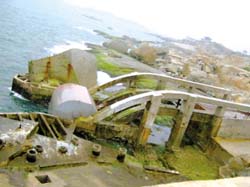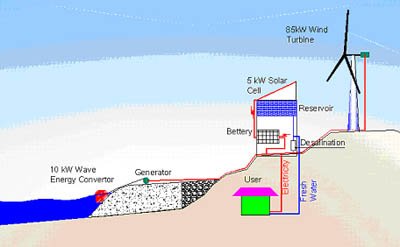

On 12 October, an agreement on the construction of a stand-alone renewable energy (RE) system at the Dangan Island was inked between the CAS Guangzhou Institute of Energy Conversion (GIEC) and the Wanshan Exemplary Marine Development Zone in Zhuhai, a coastal city in south China's Guangdong Province.
Located at the mouth of the Pearl River, Dangan Island, with 13.2 square kilometers in size, is the largest island in the Wanshan Zone with the longest coastline. With about 300 residents, the villages there are the most remote ones in the South China Sea. Currently the local people are using power produced by diesel generators, which is of low efficiency and high cost. When the new project is completed within the next year, according to Prof. YOU Yage, director of the Ocean Energy Division of GIEC, they will be using electrical power jointly produced with clean ocean energy, cutting the cost by half.
Ocean energy often refers to the renewable energy housed in the sea, including power from tides, waves, currents, thermal and salinity gradients as well as ocean wind and solar energy, says Prof. You, who is leading a 3.8 million yuan (about $506,000) research project on a stand-alone RE system with the support of the National High-tech Development Program (863 Program). While technologies for tidal, wind and solar energy could be utilized commercially, others are still under research and experiment.
At present, small-scale wave power generation system is a practical technology and stand-alone wind and solar utilization technology are relatively mature. However, it will be the first time in the world to integrate the three.
With a total investment of about 6.86 million yuan (or $913,000), the system at the Dangan will be the first stand-alone RE power system using wind, solar and wave energy sources at the same time, says Prof. You,
The bottlenecks for the project are to provide power to unstable users with a stand-alone system using three kinds of unstable energy sources. Therefore, large capacity batteries with strong charging and inverting capabilities are needed. In addition, powerful energy adjustment approaches, for instance to consume surplus energy produced to desalinate sea water to fresh water, should be available.
By adopting several patented technologies, the project is pioneering and innovative in terms of systems integration and optimum, energy efficiency and typhoon resistance, notes the expert.
The construction of the project is to be kicked off by the end of 2007. With an installed capacity of 200kW, the system will each year produce 10,000kWh, 80% of which will be provided by RE. Apart from providing enough power for lighting for the island, it will also be used for providing 10 thousand tons of fresh water each year by sea water desalination.






